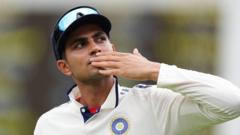In an exhilarating showdown, the India-England Test series concluded in a dramatic 2-2 draw, serving as the first significant highlight of the new World Test Championship cycle. Each match unfolded spectacularly, often reaching their climactic moments during the final day or session, offering some of the finest cricketing performances witnessed in recent years.
Prior to the series, many experts anticipated an easy contest for England, given India’s recent struggles, including a whitewash at home against New Zealand and a defeat against Australia. With key players like R Ashwin, Rohit Sharma, and Virat Kohli absent due to retirements and injuries, uncertainties loomed over India's chances, especially with young captain Shubman Gill leading a relatively inexperienced squad.
Initial concerns were validated when India lost the series opener at Headingley despite having a winning position. However, resilience emerged in the form of a stunning 336-run victory at Edgbaston, signaling India’s readiness to contest fiercely. The subsequent matches intensified, with both teams raising their performance levels in a series characterized by fierce competition and moments of skillful heroism.
Statistically, India's dominance was evident with three players—Gill, KL Rahul, and Ravindra Jadeja—earning over 500 runs compared to England's sole centurion, Joe Root. Moreover, India scored 12 centuries against England's nine, while Mohammed Siraj topped the wicket-taking chart with 23 dismissals.
Shubman Gill's remarkable series saw him amassing 754 runs, including 430 in a single match, showcasing his talent alongside cricket legends. His growth in confidence and tactical acumen highlighted India's potential going forward. Meanwhile, Siraj's persistence and fierce performance not only brought him into the limelight but also inspired the entire bowling squad.
As the series culminated in a gripping finale at the Oval, where India's resilience shone through, cricket enthusiasts witnessed a remarkable transformation. This young Indian team emerged with renewed ambition and hope, indicating a promising trajectory for the future of cricket in the nation.
Prior to the series, many experts anticipated an easy contest for England, given India’s recent struggles, including a whitewash at home against New Zealand and a defeat against Australia. With key players like R Ashwin, Rohit Sharma, and Virat Kohli absent due to retirements and injuries, uncertainties loomed over India's chances, especially with young captain Shubman Gill leading a relatively inexperienced squad.
Initial concerns were validated when India lost the series opener at Headingley despite having a winning position. However, resilience emerged in the form of a stunning 336-run victory at Edgbaston, signaling India’s readiness to contest fiercely. The subsequent matches intensified, with both teams raising their performance levels in a series characterized by fierce competition and moments of skillful heroism.
Statistically, India's dominance was evident with three players—Gill, KL Rahul, and Ravindra Jadeja—earning over 500 runs compared to England's sole centurion, Joe Root. Moreover, India scored 12 centuries against England's nine, while Mohammed Siraj topped the wicket-taking chart with 23 dismissals.
Shubman Gill's remarkable series saw him amassing 754 runs, including 430 in a single match, showcasing his talent alongside cricket legends. His growth in confidence and tactical acumen highlighted India's potential going forward. Meanwhile, Siraj's persistence and fierce performance not only brought him into the limelight but also inspired the entire bowling squad.
As the series culminated in a gripping finale at the Oval, where India's resilience shone through, cricket enthusiasts witnessed a remarkable transformation. This young Indian team emerged with renewed ambition and hope, indicating a promising trajectory for the future of cricket in the nation.






















